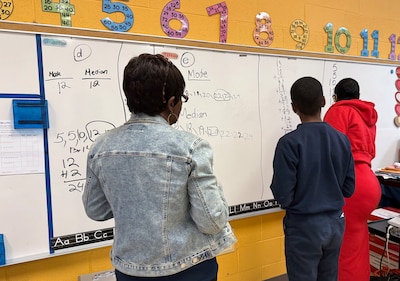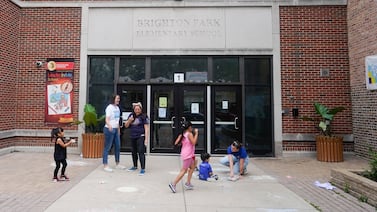Sign up for Chalkbeat Chicago’s free daily newsletter to keep up with the latest education news.
During a recent afternoon at Adam Clayton Powell, Jr. Paideia Academy in South Shore, Tressa D. McMillan quietly surveyed three students as they worked out math problems on a whiteboard, occasionally jumping in with a hint.
On the other side of the room, Karimah Dyson was helping two students add long lists of double-digit numbers and calculate the averages.
The two special education teachers were doing the same task: teaching students with disabilities about the concepts of mean, median, and mode. The difference was that McMillan has been teaching for 35 years, and Dyson is about to complete her first year as a teaching resident.
McMillan served as Dyson’s mentor this school year.
“She’s very detailed and organized. Anything you might need, from a bobby pin, she has it,” Dyson said of McMillan. “She has a ton of resources, and everyone at this school comes to her for everything.”
McMillan is one of 190 resident mentors and more than 1,100 educators who participate in Chicago Public Schools’ Teachers Lead Chicago program, which offers financial incentives to teachers who take on certain leadership roles at their schools, including mentoring new teachers and directing teams of educators on instructional coaching. The additional pay depends on the role and ranges from $1,700 a year to a full-time salaried position.
The program started in 2019 at seven pilot schools and now spans 400 largely high-needs schools, officials said. The idea for the program was rooted in a 2017 review of staffing that found women and people of color were underrepresented in CPS leadership roles, according to a new case study about the program. There weren’t enough leadership development opportunities, and “effective” teachers were leaving CPS, the study said.
CPS hosted a Friday event at Powell to celebrate the program and unveil the case study that found that teacher retention rates are slightly higher among teacher leaders.
The retention rate for teachers in the Teacher Leaders program was 88% compared to 85.7% for teachers generally across the district, according to the case study, which cited 2024 CPS retention data. That rate was 86% for Black teachers and 92% for Hispanic teachers in the program, while districtwide, those rates were nearly 82% for Black teachers and 87% for Hispanic teachers. The study didn’t include retention rates for mentees. However, 95% of school leaders with teacher leaders say retention has improved at schools, according to a survey of educators at schools with teacher leader positions.
The heart of the program is the “distributive leadership” model — sharing more power in a school rather than having a totally top-down approach, district leaders said. But it’s also meant to retain teachers, and, ultimately, improve student learning, said Nicole Milberg, chief of teaching and learning at CPS.
Current teacher demographics don’t match with the student population. While nearly 21% of CPS teachers are Black, 35% of students are Black. Another quarter of teachers are Hispanic, but 47% of kids are Hispanic. And 45% percent of teachers are white, while just 11% of students are white.
Ben Felton, chief of talent, acknowledged that the district’s challenging budget projections — which include a half-billion-dollar deficit — could result in minor cuts to the amount of stipends and number of roles that the district can fund. CPS spent $2 million centrally on the program to cover the stipend for 800 new teacher mentors and team directors. Other roles were covered through school budgets, official said.
Dyson seems like the exact educator whom district and union leaders say they want more of in CPS. Dyson, who is Black, said she grew up on the Southwest Side and attended district schools before becoming a special education classroom assistant.
After encouragement a couple of years ago from a teacher and a district official, Dyson joined CPS’s teacher residency program, which allows people to become teachers through a paid training program.
Dyson joined Powell this year as a teacher resident. While Dyson respected the teacher she worked with as a SECA, the classroom felt disorganized, and she didn’t feel like students were learning a lot.
But under McMillan’s wing at Powell, Dyson said she can see her students growing academically. McMillan has taught her how to manage her classroom and how to plan lessons, Dyson said.

McMillan said she feels like she’s learning from Dyson, too. McMillan said she’s often laser focused on running the classroom well and ensuring students are learning. But watching Dyson interact with the students reminds McMillan not to lose her compassion.
“Sometimes I do it from muscle memory,” McMillan said. “She’s doing it from heart, so she’s taught me to use my heart more.”
Reema Amin is a reporter covering Chicago Public Schools. Contact Reema at ramin@chalkbeat.org.






